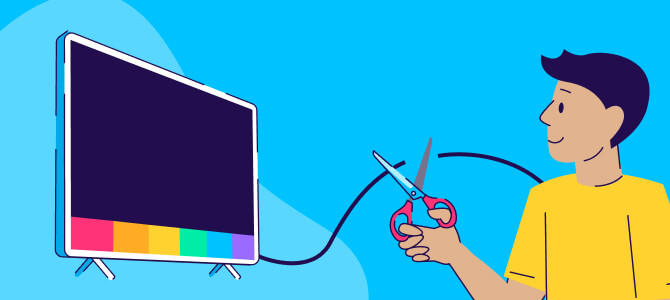
FAST Channel (Free Ad-Supported Streaming TV)
A service that offers free access to pre-programmed video channels in exchange for watching ads during pre-scheduled breaks, Free Ad-Supported Streaming TV (FAST) works like traditional TV but over the internet.
What is FAST TV?
It’s a free streaming service where users watch content on channels accompanied by advertisements.
Most FAST services like Pluto TV, Peacock, and Roku offer a wide array of free linear channels with pre-programmed content, such as new movies, news channels, TV series, talk and reality shows, and more.
If a viewer wants to watch a particular show or film on a FAST channel, they must tune in at a fixed time of the day and may be interrupted by ad breaks, much like traditional TV viewing.
This is in contrast to other video on demand (VOD) services like AVOD (Advertising Video on Demand) where subscribers can view content at their convenience, rather than adhering to a fixed broadcasting schedule.
FAST TV vs. linear TV
You can think of FAST channels as the OTT counterparts of traditional paid TV channels, as viewers must sit through ads while watching their favorite content on both.
Unlike other linear TV options, FAST channels are available on various devices, including connected TVs, smartphones, tablets, and computers, where viewers can consume content for free.
Another crucial difference is that FAST channels have lower ad loads. While paid TV’s average load is more than 12 minutes per hour, FAST is 8 to 10 minutes per hour, living up to its namesake.

Another key difference is that FAST channels use dynamic ad insertion, which means ads are delivered based on a viewer’s likes, dislikes, preferences, etc., ensuring better targeting, ad performance, and a higher CPM than traditional paid TV.
The rise of FAST
The FAST industry is experiencing exponential growth, with ad revenue reaching a whopping $2.1 billion and projected to cross $4.1 billion in the coming years.
It isn’t surprising considering that FAST services are said to attract a potential 216 million monthly active users (MAUs) next year.
The rising phenomenon of cord-cutting is fuelling the rise of FAST channels even further. More than 46 million US households will likely cancel their cable TV subscriptions in two years and replace them with streaming services like FAST.
This phenomenal rise of FAST services has compelled content publishers, OTT service providers, and advertisers to tap into the market’s potential.
But why are consumers adopting FAST services?
Primarily due to the enhanced viewing experience these channels provide, with viewers gaining access to a programming grid (similar to cable TV) and the ability to stream content from any device.
Viewers also enjoy the always-on functionality of FAST, which saves them the trouble of scrolling through never-ending content libraries on AVOD and SVOD platforms.
In the era of growing choice paralysis, it can often be confusing to constantly choose what to watch, so having a service that chooses for you is refreshing in a sense.
The FAST market – popular platforms

The increased adoption of FAST channels among consumers has grabbed the attention of established media giants, leading to numerous acquisitions:
- Pluto TV by Viacom in January 2019
- Xumo in February 2020 and Peacock in July 2020 by Comcast
- Tubi in March 2020 by Fox
With more than 68 million monthly active users and 196 exclusive channels, Pluto TV is one of the largest FAST services worldwide. Other popular ones include:
- Roku
- Peacock
- Samsung TV+
- Vizio WatchFree
- TiVo+
Types of FAST services
Platform agnostic vs. platform exclusive FAST services
Platform agnostic FAST services are available on different devices irrespective of the operating system. This means viewers can use them on a platform of their choice (any smart TV, browser, etc.) to access their favorite content. Popular examples include Pluto TV, Xumo, Peacock, and Roku.
On the other hand, a platform-exclusive FAST service can only be accessed from a specific operating system. So, viewers would have to purchase TVs from respective brands to access relevant FAST services. For instance, LG channels are exclusively available on LG webOS TVs. Other examples include:
- Samsung TV+ (Samsung smart TVs)
- Vizio WatchFree (Vizio smart TVs)
- TiVo+ (TiVO devices)
Niche / syndicated vs. branded FAST channels
Syndicated channels are usually curated and operated by an established FAST service. Examples include different thematic channels on Xumo, such as Action, Black Cinema, and SciFi.
Branded channels are published and operated by content creators or owners. Examples include Hallmark Movies, and FilmRise Free Movies.
Pure vs. premium FAST services
Pure FAST services offer linear channels with ad breaks, whereas premium FAST provides other options, such as pay-per-view or subscriptions — which allow users to avoid watching ads.
Difference between AVOD and FAST TV

AVOD is one of the most widely used video monetization models where users have to watch ads in order to view their favorite content for free.
YouTube is the most popular AVOD platform. Other examples include Hulu, Roku, and Tubi.
Similar to FAST channels, AVOD services make money by selling ad inventory to advertisers and brands.
The main difference here is that users have to tune into a FAST channel at a fixed time to be able to watch a particular film or show, which isn’t the case with AVOD platforms.
How to launch a FAST channel
You can follow these steps to get started:
- Create and curate enough content to provide a regular flow of new content on your platform.
- Find a channel origination platform to transform your existing content library into a linear channel.
- Determine your niche and monetization model.
- Outline a distribution strategy to take your FAST channel to users through websites, smartphones, and CTV apps.
- Use SSAI (Server-side Ad Insertion) to incorporate ads for linear viewing.
- Sell ad inventory to advertisers by setting a base CPM and using platforms like Google Ad Manager and Freewheel to be able to reach them.
- Set up linear channels and encode videos using adaptive bitrate streaming to provide the best viewing experiences.
- Consistently produce engaging and fresh content to keep viewers hooked to your FAST channel.
A simpler alternative for distribution is to partner with an established FAST service, such as Pluto TV or Xumo. You can leverage their existing reach and won’t have to worry about building and maintaining an app to deliver a top-notch viewing experience. It also makes selling ad inventory easier.
Key takeaways
- FAST services combine the best of traditional paid TV and streaming services by delivering an enhanced viewing experience with a wide variety of content.
- This type of service is free and can be accessed from different devices, such as smart TVs, smartphones, and tablets.
- FAST channels are linear and pre-programmed with ad breaks. They use dynamic insertion to deliver more relevant ads based on a viewer’s habits and preferences, which results in a higher CPM and better performance.
- The market for FAST services will continue to grow as more consumers pull the plug on cable TV subscriptions, making it a good time for OTT service providers to launch their channels.




